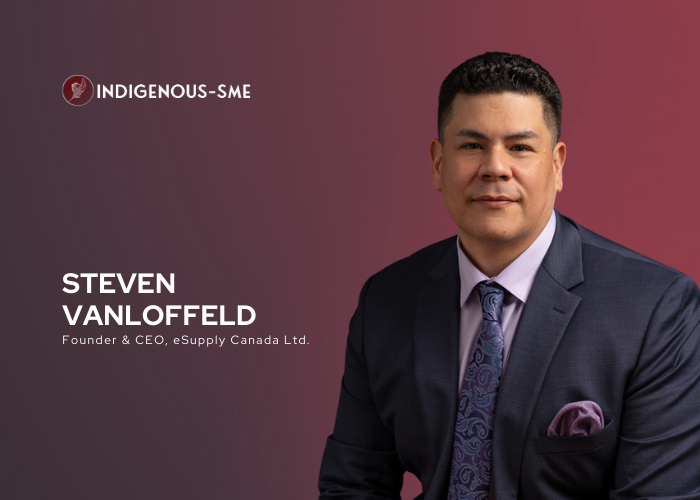In an insightful interview with Indigenous-SME Business Magazine, Steven Vanloffeld, Founder and CEO of eSupply Canada, addresses the issue of economic leakage in Indigenous communities. Economic leakage, as he explains, is the outflow of capital from these communities, exacerbated by the lack of local businesses in rural and remote areas. This results in significant revenue loss, impeding economic growth and development. Steven’s eSupply Canada confronts this challenge by enabling Indigenous communities to establish online stores for essential supplies, thus retaining and redirecting capital locally. His approach not only strengthens local economies but also aligns with his broader mission of fostering economic resilience and self-sufficiency in Indigenous communities, drawing on his extensive experience in community leadership and entrepreneurship.
Steven Vanloffeld, a multi-business entrepreneur from Saugeen First Nation, ON, is dedicated to Indigenous community economic development. As Founder and CEO of eSupply Canada, a national online distributor of business and industrial supplies, his work focuses on empowering Indigenous peoples as well as fostering understanding and reconciliation with Canadians.
Steven, your efforts at eSupply Canada are aimed at addressing economic leakage within Indigenous communities. Could you explain what economic leakage is and why it’s a critical issue for the Indigenous economy?
Simply put, economic leakage is the outward flow of capital from one community to another. Leakage happens for several reasons, usually centered around the purchase of goods and services not available in the local economy or community. As a result, you must purchase these items at another location, so revenue leaks from one location to another.
This is a major issue for Indigenous communities because many of them are rural, remote, isolated, and lack the quantity and variety of businesses to keep capital circulating within their communities.
Some communities experience as much as 90 per cent revenue leakage. That means at least 90 cents of every dollar leaves these communities. That’s a major barrier to economic development. This lost revenue means that communities are also missing out on the spending multiplier. When you purchase from a business, that business employs staff who in turn purchases the goods and services they need to support themselves and their families from other businesses.
eSupply Canada offers a simple solution for communities to begin addressing this significant issue, allowing them to launch and operate their own online storefront for office and janitorial supplies they could sell within their community. This model empowers local entrepreneurs while maintaining the flow of capital within their communities, which they could use to fund community development and other priorities.
With your extensive experience in both community leadership and entrepreneurship, how do you believe businesses, particularly in the Indigenous context, can effectively align their social impact objectives with their sales and revenue goals?
One of the most significant challenges I have found making sales calls to some of Canada’s largest companies is that, while their CEOs have made public commitments to meeting Indigenous procurement targets, their buyers are not held to account for meeting those targets.
It’s disappointing to meet with buyers of large purchasing organizations only to be told to simply go on their procurement portals, identify as a diverse supplier, and wait for opportunities. It’s even more frustrating having to update our profile and reconfirm we’re a diverse supplier every year when no opportunities have surfaced.
Yes, bringing about change takes time, particularly among large organizations, but the benefits of supplier diversity have been known for the past 4 decades—there’s available knowledge that new companies can adopt and learn from.
Here’s some ideas:
- Establish clear, measurable goals for supplier diversity
- Provide training for your procurement team on the importance of supplier diversity as well as how to identify and engage with diverse suppliers
- Develop and implement a formal supplier diversity policy
- Create incentives for procurement managers who meet or exceed diversity targets
- Conduct regular reviews and audits of procurement practices to ensure compliance with your diversity goals.
eSupply Canada is pivotal in assisting Indigenous communities to recover lost revenue through community-focused procurement strategies. What are the methods eSupply Canada implements in this process and the effects these have on the Indigenous economy?
We’re democratizing supply chains and fostering economic reconciliation by providing First Nation communities with access to their own customizable ordering portals and helping them launch their online storefront.
Our platform enables First Nations to divert the revenue they would usually spend on materials and supplies from outside retailers and into their own local businesses, while netting back a percentage on every item. These funds can then be used to support community priorities and advance its development.
Their portals function as a dropship e-commerce storefront that allow communities to earn revenue through the sale of product to community members, government, developers in their territories, or basically anyone who simply wants to support the community.
With our online drop shipping model, these communities never have to hold their own inventory or handle a customer concern. We not only provide the supply chain and product, but we also handle end-to-end customer support for them.
Your company also aids federal departments and agencies in meeting their Indigenous procurement targets. How do you navigate these partnerships, and what do you think are the key factors in successfully meeting these targets?
Public procurement is an entirely different beast and is part of our longer term strategy. While the federal government has made a 5% procurement commitment to Indigenous businesses, and all departments and agencies must be working toward that target in fiscal year 2024/25, you must still build awareness, relationships, and credibility with the public buyers.
The reality is procurement takes a lot of time, effort and investment on the part of the entrepreneur. Senior decision-makers within public departments and agencies can support this process by establishing clear targets, providing internal training and communications, incentivizing employees to meet said targets, and publicly sharing results on how well the team delivered.
At eSupply, we have a three pronged approach:
- We identify buyers through the government’s electronic employee directory and reach out to them to schedule introductory calls and capabilities presentations. We target low dollar value purchases, or anything that can be sole sourced under $25,000.00.
- We monitor the government’s public tendering sign, respond to requests for proposals, and seek to get on as many Standing Agreements as possible. Standing Agreements put you on a pre-approved short list of people the government can buy from for larger purchases.
- We attend government-hosted forums and conferences to meet with key people and to share our perspectives around procurement challenges and opportunities.
Before founding eSupply Canada, you had a significant role in transforming Indigenous child welfare and served as an Elected Councillor. How have these experiences influenced your approach to entrepreneurship and your mission with eSupply Canada?
Those experiences had a huge influence on why I founded eSupply Canada—I saw issues within my community and set out to build a solution.
As an elected councilor, I saw revenue leaving my community, higher unemployment rates, and development happening within the territory but excluding community participation because of a lack of business.
As the former executive director of the Association of Native Child and Family Service Agencies of Ontario, I saw thousands of Indigenous kids being removed from their families and communities for no other reason than poverty.
Imagine, having your kids taken away by an outside agency because their standards around what constitutes an “appropriate upbringing” doesn’t account for the impacts of Canada’s historical and ongoing legacies of unfair treatment toward Indigenous peoples.
So, in my capacity as Founder & CEO of eSupply Canada, I made it our mission to support our communities by giving them a vehicle to spend less on everyday items so they could direct those savings to what matters most: keeping children and families safe. That’s the unstated impact that governments, agencies, broader public sector organizations, and Canadian business have when they support Indigenous businesses.
By simply diverting a portion of their spend to an Indigenous-owned business, collectively we have a greater and more meaningfully impact. And at the end of the day, aren’t we all trying our best to make as big an impact as possible? I know I am.







